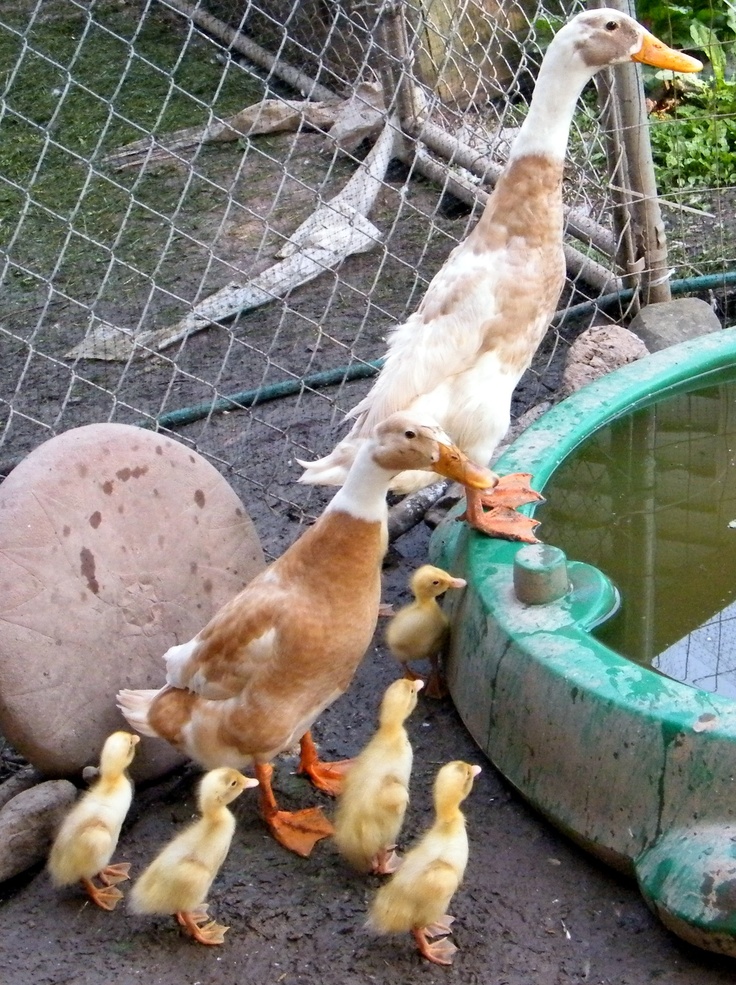Feeding baby red belly piranhas
Everything on Breeding, Diet, Care and Tank Setup
The Red Belly Piranha is becoming quite favored by aquarists who wish to add this silver-grey fish with a bright reddish-orange belly and sparkling scales to their aquarium.
Experienced hobbyists who have spacious tanks enjoy the challenge of keeping this fish with a fierce reputation. In the aquarium, however, these fish can be quite timid.
The Red Belly Piranha needs good care. We have compiled this resource guide to save you hours of research. Read on to learn about water parameters, tank size, tank set up, and a balanced diet for this unusual pet.
Contents
- Red Belly Piranha Stats
- – Red Belly Piranha Habitat
- – Red Belly Piranha Appearance
- – Red Belly Piranha Behaviour
- – Red Belly Piranha Unusual Features
- Red Belly Piranha Care
- – Water Parameters
- – Red Belly Piranha Tank Size
- – Red Belly Piranha Tank Setup
- – How To Deal With the Bioload
- Red Belly Piranha Tank Mates
- – Red Belly Piranha Gender Differences
- Red Belly Piranha Breeding
- – Red Belly Piranha Fry Care
- – Red Belly Piranha Diet
- Conclusion
Red Belly Piranha Stats
| Family | Serrasalmidae |
| Natural Habitat | Latin America |
| Behavior | Aggressive |
| Minimum Tank Size | 40 gallons per each specimen |
| Diet | Omnivore |
| Care Level | Expert |
| pH | 6. |
| Hardness | 4 to 18 dGH |
| Temperature | 74 to 82 F |
– Red Belly Piranha Habitat
Red Belly Piranhas inhabit freshwater rivers across South America. Piranhas live in loose schools of 20 to 30 in still and flowing waters with abundant foliage.
These fish are native to Argentina, Colombia, Ecuador, Brazil, Peru, Bolivia, Venezuela, Guyana, Paraguay, and Uruguay. The Red Bellied Piranha lives in large numbers in the Amazon River basin and the Parana, Paraguay, and Essequibo River basins.
You can also find this species in lakes, pools, and the coastal rivers of northeastern Brazil, as well as a great many small waterways like rivers, tributaries, and creeks. Red Belly Piranhas are omnivorous and feed on crustaceans, insects, fish, and worms.
– Red Belly Piranha Appearance
The Red Bellied Piranhas, scientific name Pygocentrus nattereri, get their name from their distinctive Red Belly, starting from the chin and throat and extending until the anal fin. These fish have beautiful coloring. Their back is shades of gray, while the rest of the body is covered with sparkling silvery-gold scales. The juvenile Red Piranha is silver with dark spots.
These fish have beautiful coloring. Their back is shades of gray, while the rest of the body is covered with sparkling silvery-gold scales. The juvenile Red Piranha is silver with dark spots.
These fish are very fast swimmers as they have large, powerful tails and streamlined bodies covered with tiny scales. Between the tail and dorsal fin, Red Belly Piranhas have another small adipose fin: this is a characteristic of all characins.
While Red Belly Piranhas can be 12 inches or longer in their natural habitat, they generally grow 8 to 10 inches long in an aquarium. This species usually lives 10-15 years, so you need to be prepared to make a long commitment to their care.
– Red Belly Piranha Behaviour
The Red Belly Piranha’s behavior in the aquarium is quite unlike the common perception. They are timid and quiet and will hide amongst the decorations of your aquarium for the majority of their time.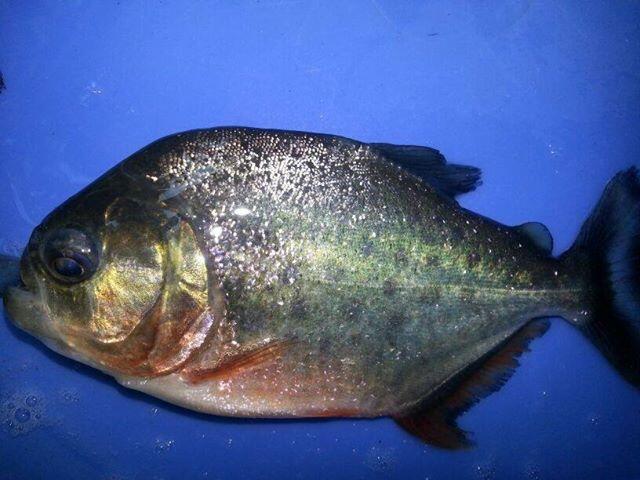 They are also quite nervous when people get close to the aquarium glass or are disturbed by hobbyists during cleaning or maintenance tasks.
They are also quite nervous when people get close to the aquarium glass or are disturbed by hobbyists during cleaning or maintenance tasks.
However, it is true that, in their natural habitat, Red Bellied Piranhas are almost constantly hunting. These predators hunt in shoals of 30 or more fish, hiding until they attack their prey. If they smell blood, it sends them into a frenzy.
You should be very careful when handling these fish, as their razor-sharp teeth could be a source of serious injuries for their tank mates or even for unfortunate aquarists. Their activity level and aggression increase at feeding time, so it is necessary to be very attentive.
– Red Belly Piranha Unusual Features
Red Piranha has an acute sense of smell, which enables them to find their prey. These fish also have a line of special sensors down the sides of their bodies, known as the lateral line system.
Red Belly Piranha makes a drumming sound by contracting and relaxing the muscles around the swim bladder to produce noises of different frequencies.
Red Belly Piranha Care
Red Piranha Care needs to live in a tank with consistent water quality, as these fish are carnivores and very messy eaters. The water should be well-cycled at all times. In addition, add a powerful canister filter. As they chew their food, Red Bellied Piranhas scatter lots of meat particles into the water, leading to ammonia and nitrates’ spikes.
We suggest you install a quality filtration system to deal with the bioload and prevent the build-up of nitrates in the aquarium. You will also need to carry out a water change of 30 to 50 percent every other week.
However, Red Belly Piranhas are surprisingly shy. It would be best to keep the tank in a quiet spot since Piranhas can get anxious and distressed when too many people walk past the tank. When these fish are stressed, they may become aggressive.
When these fish are stressed, they may become aggressive.
This species lives in rivers in the rainforest with thick vegetation to protect the fish from direct sunlight. The waters are quite murky, so their eyes have adapted to low lighting. The Red Belly Piranha will be happiest and stay healthy if you place their tank in a quiet, dimly lit area away from lots of traffic.
Furthermore, direct sunlight or heat can result in bacteria multiplying rapidly, which can harm your Piranha’s health. Try to keep the temperature at 75 to 80 F. You shouldn’t put the tank in a place where there’s direct sunlight or close to radiators or heaters.
– Water Parameters
Red Belly Piranhas are very hardy fish that can tolerate a vast range of water conditions. To provide them with optimal water conditions, maintain the temperature of the tank water between 76 – 82 F and the pH levels between 6.0 and 7.5.
It is vital to clean the tank weekly for your Red Bellied Piranha’s health. We suggest replacing at least 10 – 20 percent of the water every week, or more bi-weekly (up to 50 percent). It would be best to clean the tank walls and gravel to prevent odor and bacteria that can cause the fish to fall ill.
We suggest replacing at least 10 – 20 percent of the water every week, or more bi-weekly (up to 50 percent). It would be best to clean the tank walls and gravel to prevent odor and bacteria that can cause the fish to fall ill.
Write out a weekly maintenance schedule so that you don’t forget. Remember, Red Belly Piranhas are messy, so you may need to clean the aquarium more often if you notice excess waste or odor. It won’t take more than ten minutes.
Try not to remove your Piranhas from the tank. Remember that Red Piranhas generally attack when they are frightened or hungry. Wear heavy gloves when cleaning the tank. If it is necessary to remove your Piranha from the water, use a bucket or large net.
– Red Belly Piranha Tank Size
Red Belly Piranha aquarium needs to be spacious. You can keep one single Piranha in a 40-gallons aquarium, but you’ll need to consider buying a very large tank for an entire group. These fish are skittish, and they will be less shy if you keep them in a group of four or more. They are happiest in an aquarium with lots of hiding places and plenty of space to swim around.
These fish are skittish, and they will be less shy if you keep them in a group of four or more. They are happiest in an aquarium with lots of hiding places and plenty of space to swim around.
You can keep baby Red Bellied Piranhas in a small 20-gallons aquarium for a while, but adult fish will need at least 100 gallons or more, depending on how large the group is. These freshwater river fish from South America will thrive in a horizontal tank with a strong current.
If you keep Red Belly Piranha cramped in a small tank for a long time, it can stunt their growth. Moreover, the juveniles tend to be cannibalistic, so keeping them in a large tank is advisable to prevent them from attacking and eating their siblings.
– Red Belly Piranha Tank Setup
Red Belly Piranha aquarium should replicate their natural environment. You may want to create an Amazonian biotope aquarium using driftwood, bogwood or submerged wood root, and lush plants to provide cover and diffuse the lighting.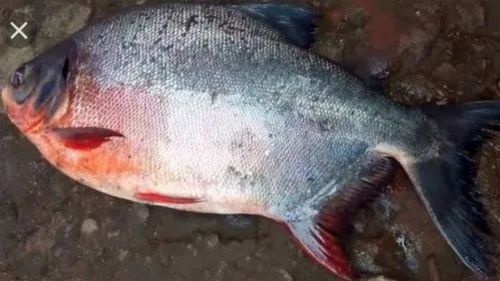
You must be careful not to use rocks or driftwood with sharp pointed edges or corners that could injure the fish. Sand would be a good substrate, but a thick layer of very fine gravel is good too. Leave plenty of open swimming areas. The aquarium should have a secure lid to prevent these fish from jumping out if they feel threatened or frightened.
Some fish enthusiasts keep their Piranhas in bare tanks for easier cleaning and maintenance. However, you can use a thin layer of smooth rocks and gravel to cover the bottom of the aquarium.
– How To Deal With the Bioload
Red Belly Piranhas eat large amounts of food and produce a great deal of waste, so that you will need a large filter with good mechanical and biological capability. Or you could install more than one oversized external filter. We suggest buying units with in-built heaters or a sturdy heater guard as these fish are large and active and can knock against equipment and damage it.
Alternatively, you could use Sump systems since you can house the heater inside them. If your tank capacity is less than 1,000 or 1,200 gallons, you should change 30 – 50 percent water every week.
Installing a powerhead to create current would be a good idea since Red Bellied Piranhas love to swim in currents. It is good for these fish, as exercise boosts their metabolism and increases their growth rate.
Red Piranhas dislike very bright light because it makes them feel exposed and unsafe since the water in their natural habitat is either murky or covered by overhanging plants. Light may also cause injury to their eyes, as Red Belly Piranhas do not have eyelids.
Red Belly Piranha Tank Mates
Red Belly Piranha tank mates can be challenging to choose. The Red Belly Piranha is a predator capable of attacking fishes of any size and can attack even its tank mates sooner or later.
Most Red Piranha hobbyists keep these fish in groups of three to ten in a species-only aquarium, as this seems to be the best way to keep Piranhas. Some possible tank mates may be semi-aggressive species like Large Cichlids, armored Catfish, Pacus, and Silver Dollars.
Possible Tank Mates for Red Belly Piranhas:
- Red Belly Piranhas
- Armored Catfish
- Peaceful to semi-aggressive fish like large Barbs, many Catfish, or Cichlids
- Danios, Guppies, and other small fish
Tank Mates to be avoided for Red Belly Piranhas:
- Territorial and aggressive fish like certain Cichlids, Catfish,
- Gouramis, Mollies, Angelfish, Platies, Rainbowfish, and other medium-sized fish
– Red Belly Piranha Gender Differences
Red Belly Piranhas do not have any visible differences between the sexes. A female may get rounder as she fills with eggs, while the color of the males intensifies before spawning.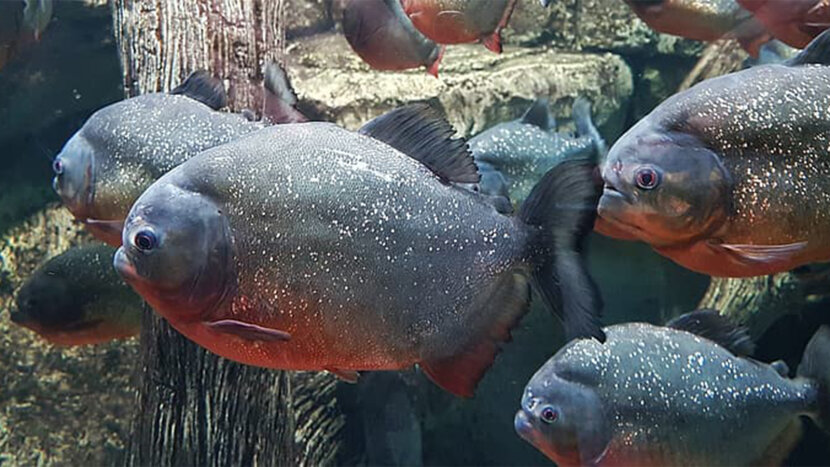
Red Belly Piranha Breeding
Red Belly Piranha breeding is possible if your group of fish forms pairs. These fish become sexually mature when they are one year old. When it’s time to breed, the male will dig out a nest in the substrate using their mouth and caudal fin, and defend it against other males.
After the nest is ready, the male fish chases the female one towards it, and they start swimming in circles. When these fish are ready to spawn, their color darkens. The female fish lays several eggs that the male then fertilizes. If you have a spacious tank, you may see several pairs spawn simultaneously.
Spawning is an entire process that starts in the early morning and carries on for almost the entire day. The female lays 500 to 1500 eggs in an hour. Red Belly Piranha eggs are bright orange and about 2 mm big. The male Piranha chases the female away from the nest after she has laid the eggs.
The male Red Belly Piranha takes over the care of the eggs. He guards the eggs and fans them with his fins. The male covers the eggs with the substrate and waves the clutch with their fins to create a water flow. After three or four days, when the eggs hatch and the larvae appear, they are still attached to the yolk sac. They get nourishment from the yolk sac for four days.
– Red Belly Piranha Fry Care
The Red Belly Piranha fry starts to swim in a week. We suggest transferring the fry into smaller tanks with sponge filters. Give them chopped Artemia nauplii, baby brine shrimp, or micro worms three times a day. You will need to carry out 10 percent water changes daily.
The fry are cannibalistic and eat their siblings, so you will need to keep moving them in groups to larger tanks. Juvenile Red Belly Piranha grow very fast. 1-month-old Piranhas already look like small, shiny coins with a dark dot at the base of their tail fin.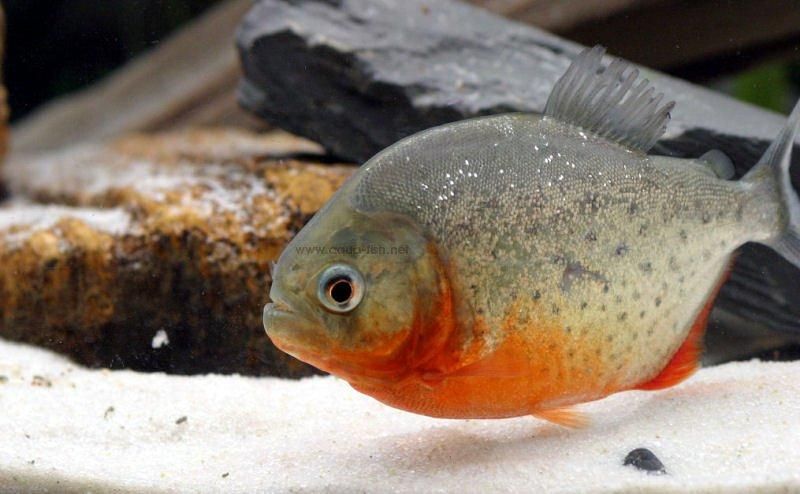
When they reach two months of age, more dark spots appear all over their bodies. They look like the adult Red Bellied Piranha at three months as their bottom jaw becomes more prominent and their fins become colored.
Once the juveniles are three months old, adding meat, fish, and chopped shrimp to their diet is essential. When you introduce fresh or frozen food to the diet, monitoring the tank water quality is important as it can get fouled very quickly.
– Red Belly Piranha Diet
The Red Belly Piranha diet is omnivorous. They eat fish, crustaceans, insects, aquatic invertebrates, algae, and aquatic plants. Remember that they will also look at smaller mammals and birds that inadvertently get too close to the water as prey.
Red Belly Piranha will eat a wide variety of meaty food; however, they will not get proper nutrition and a balanced diet from these processed foods. Piranhas will eat live fish. However, captive-bred feeder fish are often kept in crowded aquariums in very poor water conditions.
However, captive-bred feeder fish are often kept in crowded aquariums in very poor water conditions.
Feeding live feeder fish can lead to disease, so it is recommended not to use them. If you wish to offer feeder fish to your Piranhas, it is essential to quarantine the feeder fish for two weeks before you feed it to your Red Belly Piranha to prevent any disease from spreading to your fish.
A good staple diet should include a variety of frozen, freeze-dried, and live foods like quality meaty frozen food, frozen silversides, chopped fish, prawns, mussels, krill, worms, insects, and crustaceans.
Offering the Right Amount of Food
You should vary the items you feed your Piranha. We suggest you check the size and width of your fish before deciding the quantity your fish should eat and the feeding frequency.
We suggest you begin by offering your fish small amounts of food every day or every other day. Continue to monitor the growth rate and overall weight and size of the fish.
Continue to monitor the growth rate and overall weight and size of the fish.
You should feed Juvenile Red Bellied Piranhas twice a day and reduce the frequency as they mature and become adult fish.
It is not advisable to give Red Belly Piranhas animal meat such as chicken or beef heart because they contain too much fat and protein, which the fish cannot digest. Offer these fish a balanced diet.
Conclusion
The Red Belly Piranha is the most commonly available Piranha, and they make a beautiful display in the aquarium.
- The Red Belly Piranha grows eight to ten inches long in an aquarium
- These fish need to be kept in a large aquarium
- This species usually lives 10 – 15 years
- These fish have sparkling scales on the side of the body
- Red Belly Piranha dislike bright light
- This species are very fast swimmers
- The female Red Belly Piranha lays her eggs in a nest
- The male Red Belly Piranha takes care of the eggs
- These fish are very easy to feed
- Juvenile Red Belly Piranha are cannibalistic
If you are looking for an uncommon fish that will challenge your fishkeeping skills, you couldn’t find a better option than the Red Belly Piranha to add to your aquarium.
Badman's Tropical Fish
Badman’s tropical fish is the largest and most comprehensive aquarium related resource on the web. We focus on making the lives of aquarists and fish keepers easier.
Piranha Fish Care Sheet: Setup, Feeding, & More
Piranha fish are world famous at this point and a popular culture icon. Their very name conjures images of muddy waters full of small freshwater fish that have razor-sharp teeth and a thirst for blood, like sharks in miniature. The truth is both less and more impressive than this.
While they are very much meat eaters, Piranha care is not at all what you might be thinking! In fact, many of the most common species are downright skittish! Still, you’re better off keeping your fingers outside the tank at all times…Let’s talk more about Piranha care.
About Piranhas
In the aquarium, many Piranha fish are quite timid and yet still very dangerous, for reasons we’ll get to soon. The truth is that they do have seriously sharp teeth and true to the legends, they can effortlessly shear flesh from their prey, tankmates…or your hand if they decide to try. Piranha aquarium maintenance is more delicate than is typical for fish tanks but not as scary as you might think.
Piranha aquarium maintenance is more delicate than is typical for fish tanks but not as scary as you might think.
Piranhas are actually very closely related to Tetras and many live in the same native habitats. They used to be classified in the same family (Characidae) but have since been moved to their own family (Serrasalmidae). Neon, Cardinal, and especially Black Skirt Tetras have more than a few passing resemblances and habits.
Like their tiny cousins, Red-Bellied Piranhas tend to hang in loose shoals rather than true schools. They spend most of their time displaying to one another, giving short chases, and waiting for food to appear.
There are over a dozen genera of piranha in the wild and many species. However, there are only a handful that ever make it into the hobby. And of those, only three are common enough to be readily identifiable by non-Piranha keepers and ichthyologists.
Piranha Species Profiles
There are dozens of Piranha species in the wild but these are the only two you’re likely to ever see. Speciality warehouses and distributors may carry other species on rare occasions. Their care requirements are generally identical to either of these two species, depending on whether they are shoaling/social or solitary/loners.
Speciality warehouses and distributors may carry other species on rare occasions. Their care requirements are generally identical to either of these two species, depending on whether they are shoaling/social or solitary/loners.
Red-Bellied Piranha
If you’ve ever stumbled upon a Piranha species at a local pet store or even a museum, chances are you were looking at Red-Bellied Piranhas. 95% of the Piranhas in the trade are this species. Their brilliant red bellies and somewhat social character make them the most appealing Piranhas to care for.
Red Bellies are medium-sized as adults, with 8-10 inches being standard for them. They are also the easiest species to keep with other fish so long as they are kept well fed.
- Scientific Name: Pygocentrus nattereri
- Origin: Amazon Basin, South America
- Length: 8-10 inches
- Aquarium Size: 75+ Gallons
- Temperament: Aggressive; Shy
- Ease of Care: Moderate
Black (White) Piranha
Black Piranhas, also confusingly known as White or Red Eye Piranhas, are the second most common Piranha species. Unlike Red Bellies, they are aggressive, solitary predators that aren’t skittish at all. Since they live alone they don’t group into feeding frenzies.
Unlike Red Bellies, they are aggressive, solitary predators that aren’t skittish at all. Since they live alone they don’t group into feeding frenzies.
In fact, they have very cichlid-like confidence that can be intimidating with their razor-sharp teeth. Also, you should know how large they get – up to 20 inches! They will watch you as you move around and may even try to nip at cleaning tools that enter the tank.
One should always keep Black Piranhas alone or with fish too small for it to bother trying to eat, like Guppies and Tetras. They are slow-growing, on the order of an inch per year. But they have a subtle coloration and are incredible show fish, assuming you have the space for one.
- Scientific Names: Serrasalmus rhombeus
- Origin: South America
- Length: 16-20 inches
- Aquarium Size: 180+ gallons
- Temperament: Aggressive
- Ease of Care: Moderate
Are Piranhas Legal to Keep?
Here’s something you may not know: Piranhas aren’t legal in many US states. They require warm, tropical temperatures to survive and would not be able to live year-round in all but the warmest climates.
They require warm, tropical temperatures to survive and would not be able to live year-round in all but the warmest climates.
A Piranha population can’t survive in most of the country. But they’ve captured the popular imagination enough that a significant number of states have banned them despite there being no danger of wild Piranhas naturalizing.
Many times a “Piranha” found in local waters is actually a Pacu, as this article by the Guardian found.
Piranha Fish Care
So long as you’re aware of the challenges involved, caring for Piranhas is fairly straightforward.
Piranha Fish Tank Size
A spacious aquarium is paramount for Piranhas for several reasons. One reason is that their sharp teeth make them very messy eaters that require a carnivorous diet. Meat-eating fish that chew their food release tons of flesh particles into the water that decay and contribute to ammonia and nitrates. A mature, well-cycled aquarium with a powerful canister filter is mandatory for their health.
Aquarium size is even more important for the Black Piranha, which reaches 20 inches as an adult. Fortunately, they are extremely slow-growing fish. They may only grow one inch per year, so you have at least a decade before you’ll need to go beyond 100 gallons.
Red-Bellied Piranhas, on the other hand, can be found as youngsters as small as an inch long! They do grow quickly but can live comfortably as adults in tanks as small as 75 gallons. Just remember that they are shoaling fish and should be kept in groups of 3-12 whenever possible.
Another important reason Piranhas require space is because they are extremely skittish fish! Far from the ultimate Amazonian predators (except for the Black Piranha), Red-Bellied Piranhas are very easily frightened by sudden movements because many things, including people, love eating them.
150w/300w/500w in-Line External Heater Aquarium Heater - 150/300/500 WATT...
- The ISTA in-line external heater is designed for.
 ..
.. - The ISTA External Heater must be used in a...
- The ISTA External Heater is easily installed by...
In fact, you should avoid using standard glass heaters in a Piranha tank as they are likely to dash against it, shattering it and potentially electrocuting your fish. Expert Piranha keepers use either heater guards or in-line heaters to avoid fatal damage.
Water Conditions for Piranha Fish
As I mentioned earlier, Piranhas are messy carnivores. So heavy filtration and frequent water changes are essential to keeping their water free of ammonia and other nitrogenous waste products.
For parameters, you’re looking at standard tropical South American conditions, which range from a pH of 5.5-7.0 and temperatures from 75-85℉. Piranhas require extremely warm waters as they are found in the shallow, slow-flowing portions of rivers and streams.
Piranhas inhabit waters in South America that are stained a dark tea color by plant tannins and humic acids. These chemicals can drop the pH very low. While they don’t require a blackwater aquarium they do need a pH that’s on the moderate to low side to stay healthy.
These chemicals can drop the pH very low. While they don’t require a blackwater aquarium they do need a pH that’s on the moderate to low side to stay healthy.
You may already be thinking about how to perform water changes in a Piranha tank. Some aquarists decide they aren’t intimidated by their fish and simply go in and wash the glass and vacuum the gravel normally. While they are unlikely to be bitten, it’s also not out of the realm of possibility.
The problem with Red Belly Piranhas isn’t that they are aggressive, it’s that they are unpredictable. When feeling threatened, they both flee and bite. So if your arm is in their way, and they are seriously fast fish, they may snap at it in self-defense. It’s better to attach your siphon hose to a pole or use a siphon long enough to not require you sticking your hands into the tank.
Black Piranhas are much bolder, making cleaning a real challenge. They will even bite at magnetic glass cleaners and are often waiting at the surface to feed when you open the lid for water changes…
Plants and Decorations
Plants are an important part of Piranha care.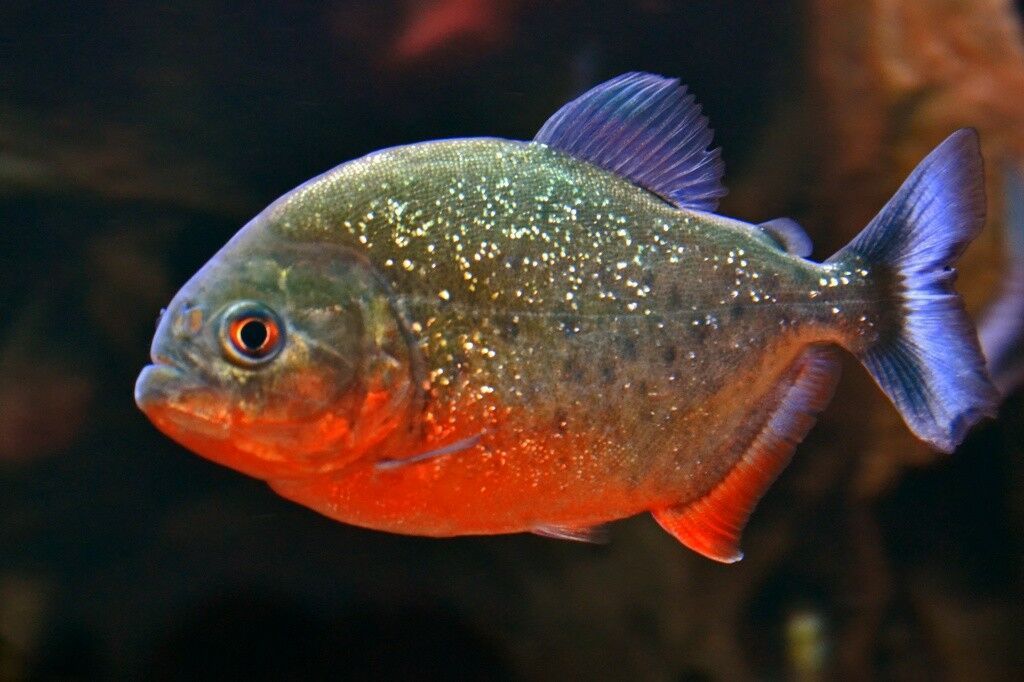 They are very plant safe for such large fish. In fact, plants are highly recommended for Red-Bellied Piranhas because they provide nearby cover, helping them feel less exposed and thus, skittish.
They are very plant safe for such large fish. In fact, plants are highly recommended for Red-Bellied Piranhas because they provide nearby cover, helping them feel less exposed and thus, skittish.
Since they are fairly large, active fish, they may bowl over thickly planted or loosely rooted plants. And their love of extremely warm temperatures may be too much for many plants, which prefer being kept below 80℉. Any of the plants recommended for Discus and Angelfish are great choices for Piranha aquariums as they thrive in hot, acidic conditions.
You need to be very intentional with choosing your decorations because Piranhas will crash into them when startled. Sharp edged rocks and pointed driftwood should be avoided in favor of smooth edged pieces.
Brightwell Aquatics Blackwater - Liquid Humic Substance Conditioner for Planted...
- Establishes similar water conditions to those...
- Help simulate the onset of the rainy season for.
 ..
.. - Enhances the effectiveness of plant nutrient...
Driftwood also provides a slow-release source of plant tannins, which buffer the pH towards acidity. If you’re looking to provide true blackwater conditions for your aquarium fish, consider also using a blackwater extract formula. This way, water changes won’t remove what few tannins your driftwood leeches over time.
Tank Mates for Piranha Fish
Choosing tank mates for Piranhas is one of the more challenging aspects of keeping them. Unfortunately, your best bets are either other Piranhas or freshwater fish that you don’t mind losing if your Piranhas decide they look tasty.
Well-fed Red Belly Piranhas are fairly tame towards their tank mates and can be kept alongside other fish their size or larger. Large Cichlids like Peacock Bass, armored Catfish, and related fish from South America like Pacus and Silver Dollars are your safest choices. However, you can also try keeping them with tiny fish that are beneath their notice. Guppies, Zebra Danios, and other fish species are often too small to be worth chasing if your Piranhas are fed often. No guarantees, though.
Guppies, Zebra Danios, and other fish species are often too small to be worth chasing if your Piranhas are fed often. No guarantees, though.
Good Tank Mates for Red Belly Piranhas:
- Other Red Belly Piranhas
- Peaceful to Semi-Aggressive Community Fish (Cichlids, many Catfish, large Barbs, etc)
- Guppies, Danios, and other small Community Fish
- Armored Catfish
Poor Tank Mates for Red Belly Piranhas:
- Gouramis, Platies, Mollies, Rainbowfish, Angelfish, and other medium-sized Community Fish
- Territorial, Aggressive fish (Certain Cichlids, Catfish, etc)
Black Piranhas must be kept solitary or again, with aquarium fish that are beneath their notice. They are likely going to take a chunk out of any sizable tank mate that’s around if you miss a feeding. Or they may bite just because they felt like it.
Feeding Piranha Fish
Feeding Piranha fish, on the other hand, is just about the easiest aspect of keeping them! As you might expect, Piranhas eat any sort of live or dead meat you offer them. But that doesn’t mean that you really should give them anything.
While it’s okay to offer it to them occasionally, birds and mammals aren’t too good for them. Their meat is much fattier than aquatic animals, which can lead to fat building up in their body cavity and especially the liver. Piranhas evolved to eat mostly aquatic fare with the occasional fruit and nuts dropped from overhanging trees.
Chunks of thawed shellfish and white fish are the best thing you can feed them. Frozen mussels, squid, shrimp, and any cheap white fish from the seafood aisle will do. Feeder fish are a poor choice because they are starved, nutritionally speaking. They are fed poor-quality flakes for their short lives and are loaded with bacteria and parasites that get passed right onto the Piranha.
They also don’t need to be fed every day. One hearty feeding every other day is enough for Piranhas. They will eat heavily during a single feeding and then digest for a day.
Breeding Piranha Fish
Breeding is one aspect of Piranha care that you may be fortunate to witness if you manage to succeed at everything discussed here! They spawn occasionally but not very often in home aquariums. It takes the right temperatures, age, pairs, and water conditions to pull it off.
Red Belly Piranhas aren’t sexually dimorphic – meaning, you can’t tell them apart by looking. The fish somehow know; likely through behavioral and hormonal cues. Females will swell slightly when gravid and preparing to spawn.
Captive spawnings almost always take place when groups of 6 or more fish are kept together in tanks larger than 150 gallons. They pair off and the male will dig a shallow pit; a soft substrate like sand makes his job much easier. The female deposits her eggs, the male fertilizes them, and then drives her and any other fish that approaches off until they hatch.
The eggs take around 4 days to develop and hatch. Once the fry emerge, they subsist solely on their yolk sacs for another 4 days, though. Once they run out of yolk they are free-swimming and able to feed on brine shrimp nauplii, micro worms, and other small, live prey.
You should siphon them from the male’s nest into a fry rearing tank at this point or sooner since he will stop caring for them and the fry will be eaten by other fish or sucked into the filter. Red-Bellied Piranhas grow quite rapidly, around ½ – 1 inch per month, and are ready for resale to local aquarists and pet stores in just a few weeks!
Piranha: Conclusion
Most of these care tips apply to both the Red Bellied Piranha because it is by far the most common species of Piranha fish in the hobby. However, if you want to try keeping a Black Piranha, you are still going to be well informed by this care guide.
Just remember that the Red Bellied Piranha is a skittish fish that needs special care and a meaty diet. And try not to reach into the tank too often and few mishaps should occur.
And try not to reach into the tank too often and few mishaps should occur.
More Frequently Asked Questions about Piranha Fish
Still not sure if Piranha fish are right for you? Then let’s talk about a few more facts surrounding piranha fish and piranha fish care.
Can Piranha Fish Eat Humans?
Yes, they can. Piranha fish have powerful jaws and large, razor-sharp teeth that they use to slice chunks of flesh from other animals. They don’t usually eat animals larger than them but if hungry or frightened they can quickly dash in and bite. This behavior can then trigger other Red-Bellied Piranha fish to follow, causing feeding frenzies to erupt.
Is Piranha Fish Aggressive?
Red-Bellied Piranha fish and other Piranha species are usually not very aggressive. But Black Piranhas are very aggressive and will kill most other fish in the same aquarium as them.
Can You Keep Piranha Fish as Pets?
Piranha fish belong to the family Serrasalmidae, which includes many popular aquarium fish from South American rivers, like Pacus and Silver Dollars.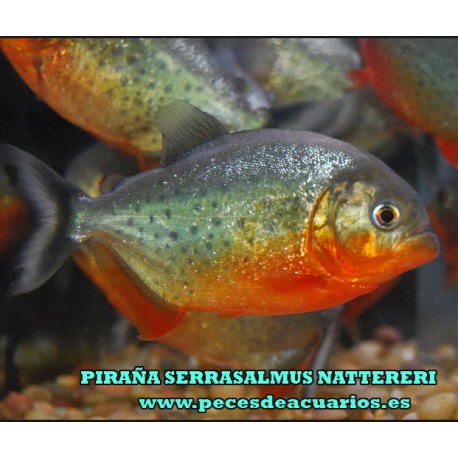 They can be kept as pets but they are moderate to difficult to care for. Red-Bellied Piranha fish are very skittish and unpredictable, which makes them sometimes dangerous. But when well fed and kept in stable conditions they calm down enough to make beautiful and long-lived pets. Black Piranhas are much calmer but have to be kept alone because they are large and very territorial.
They can be kept as pets but they are moderate to difficult to care for. Red-Bellied Piranha fish are very skittish and unpredictable, which makes them sometimes dangerous. But when well fed and kept in stable conditions they calm down enough to make beautiful and long-lived pets. Black Piranhas are much calmer but have to be kept alone because they are large and very territorial.
How Fast Can a Piranha Eat a Human?
Experts from Popular Science found that between 300 and 500 Piranha fish would decapitate a human in around 5 minutes. In Piranha-infested waters, the fish will enter a feeding frenzy where they quickly strip a body bare of flesh within mere minutes. And since they swim in schools it’s entirely possible for them to completely eat a person.
In South America, this is most dangerous in the dry season when the water levels are very low. The piranha fish have likely eaten everything else in a body of water and are starving. A person suddenly jumping into those waters may then be attacked by a school of Red-Bellied Piranha.
The Bala Shark, Silver Giant of the Home Aquarium
Neon Tetra Fish: The Ultimate Care, Diet, Breeding, & Info Guide
About Jason Roberts
Jason is an aquarium fanatic that has been a fish hobbyist for almost three decades.
Piranhas, maintenance, feeding and breeding
Red-bellied piranha or red piranha (lat. Pygocentrus nattereri) is a predatory fish species. It belongs to the piranha subfamily Serrasalmidae , which is one of the best known piranha species. Thanks to Hollywood films, he is known as a bloodthirsty predator, but are piranhas so dangerous? Further in the article you will find information about their habitat, how they hunt, how to keep fish in an aquarium and whether it is possible to keep piranhas along with other inhabitants of the aquarium.
Wildlife Habitat
Red-bellied piranha was first described in 1858. The Latin name is given in honor of the Austrian naturalist Johann Natterer. There is a lot of discussion and disagreement about the scientific name, so it is possible that it may change later. However, nowadays this fish is called Pygocentrus nattereri .
There is a lot of discussion and disagreement about the scientific name, so it is possible that it may change later. However, nowadays this fish is called Pygocentrus nattereri .
The red-bellied piranha is found in the Amazon River and the Amazon Rainforest, the Paraguay-Parana and Northwest Brazil coastal river basins, and the Essequibo River basin. The basins of these rivers are found in Argentina, Bolivia, Brazil, Paraguay, Ecuador, Guyana, Peru and Uruguay.
Fish have a wide range of geographic variations. Its population in the south is characterized by a golden yellow belly and is often referred to as P.nattereri "ternetzi", but this does not make it a separate species of piranha. This name came about when Steindachner described the damaged holotype and named it Serrasalmo ternetzi. It is also quite common to see the name "superreds". However, the color of the fish may change when kept in an aquarium depending on the conditions in the aquarium and the food received.
These fish live in huge schools that spend most of their time looking for prey. The fish are quite greedy. Therefore, she can only live in waters rich in fish. Most often, red-bellied piranhas can be found in some shallow waters, in deep and muddy waters. Again, as one of the most famous piranha species, it has a reputation as a freshwater predator that is dangerous to both humans and animals.
Are piranhas dangerous? Aggression in nature and in the aquarium
Based on movies and literature, we know that if we just dip our hand into piranha water, they will eat it in a minute. Well, maybe it's not so dramatic, but if there is some kind of injury on the arm and blood gets into the water, the piranha can smell it from miles away, and the whole pack will attack the person and leave behind only a skeleton.
Is this really so?
First, we have to understand if the piranha is really an extremely aggressive creature that attacks everything that moves in the water.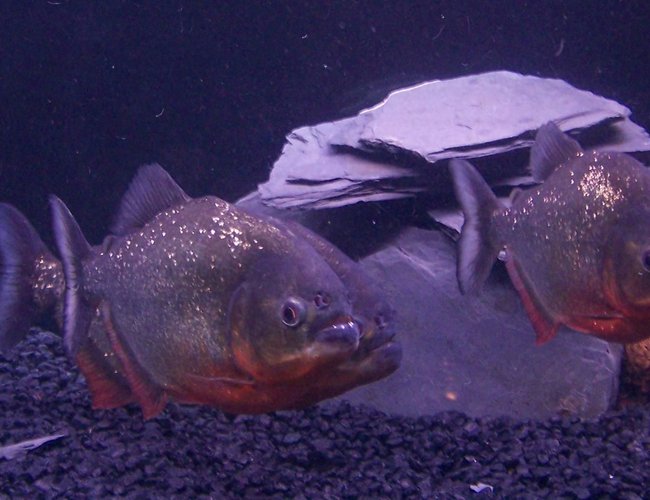
It may sound strange, but piranha is a very cautious fish that does not pose a threat to humans. There are many cases when a person swam harmlessly in water full of piranhas.
Jeremy Wade was the one who showed it to the fullest. He placed the piranhas in a small pool and swam there, while several dozen piranhas did not even come close to him. However, piranhas, thought to be flesh and blood predators, are actually quite timid fish.
They are known to prefer to live in large flocks, so if you see one piranha in the water, there are definitely more of them. However, they remain in schools not because it is easier to kill a person in this case, but because they themselves are part of the food chain for other larger fish species. In a school of ten fish, the chances of being eaten are pretty low.
Moreover, experiments have shown that fish do not feel as calm when they are alone as if they are surrounded by others. However, despite their peaceful demeanor towards humans, piranhas are veritable killing machines for other fish species lower down the food chain.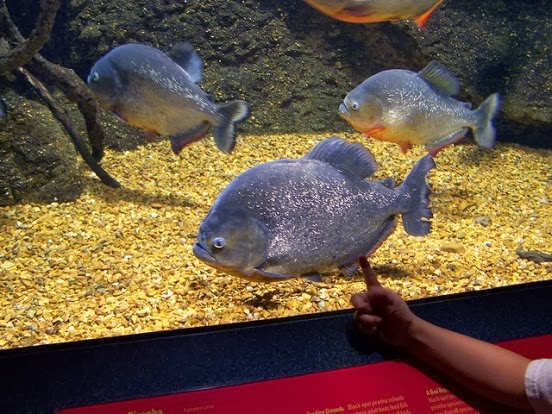 Their strong jaws are built for biting and tearing, while their hard, muscular bodies are capable of moving and twitching incredibly fast underwater.
Their strong jaws are built for biting and tearing, while their hard, muscular bodies are capable of moving and twitching incredibly fast underwater.
A piranha bite is between 67 and 320 Newtons which is quite a lot for such a small mouth. This is the strongest bite of all fish (corresponding to body size), and it is three times stronger than the bite of alligators of the same size.
However, this does not mean that these fish never bite people or animals that have fallen into the water. Almost always, this behavior is not due to their aggressiveness, but due to self-defense or abnormal weather conditions. Due to the change in weather, their behavior is radically different from usual.
By abnormal weather we mean the dry season, when the rivers become too dry and the fish are cut off from the main stream in water holes, many fish are left to starve. These hungry predators gradually begin to eat their own kind and may well attack any creature that has fallen into the water.%2059f%20juvenile.jpg) Sometimes the piranha's propensity for aggressive behavior is discovered during the spawning period, when they attack people or animals as a self-defense. However, such cases are quite rare.
Sometimes the piranha's propensity for aggressive behavior is discovered during the spawning period, when they attack people or animals as a self-defense. However, such cases are quite rare.
Description
In the wild, the fish grows to about 30 cm in length, but in aquariums it is much smaller. The total lifespan of the red-bellied piranha is about ten years, but there have been cases where the fish has lived for more than 20 years.
Piranha is a silvery fish with a tall body, greenish-blue back, reddish-orange throat and belly. It seems rather harmless, but for its large head with a pronounced jaw with sharp, hard triangular teeth that leave no doubt that this is a dangerous predator.
The teeth on the upper jaw are slightly smaller than those on the lower jaw. At the same time, as a rule, they are covered with massive fish lips, and only their ends are visible. The special organization of the teeth and the movable lower jaw make it possible to tear rather large pieces of meat from the prey.
Predatory lifestyle has affected the size of fish eyes and nostrils. Piranhas have an excellent sense of smell, and they can find their potential prey even in complete darkness among dense vegetation.
The color of the fish depends on its habitat. The color of the abdomen varies from yellowish to reddish, while the rest of the body is silver, golden or black. The shape of the head can be different, primarily it depends on the diet. Some species have a rather blunt head, and some have a slight concavity above the eyes, which may sometimes be absent. The size of the fin depends on the characteristics of the diet and habitat - sometimes the fin can be quite tiny.
In young fish, black spots are scattered over the silvery body. Their gill covers, pectoral and anal fins, including the abdomen, are bright red. The tail has a wide rear edge.
With age, black spots disappear, and the body becomes dark silver with small gold sparkles on the scales. At the same time, the red color on the fins and abdomen is preserved. There are no rays on the adipose fin, and from 14 to 18 branched rays on the dorsal fin. The caudal fin, which extends from the ventral to the anal, is covered with serrated scales in the form of teeth.
There are no rays on the adipose fin, and from 14 to 18 branched rays on the dorsal fin. The caudal fin, which extends from the ventral to the anal, is covered with serrated scales in the form of teeth.
Piranha as a pet and difficulties in keeping
Due to the many myths about the bloodthirstiness of fish, piranhas are quite rare in hobby aquariums, although they require minimal care.
The fish is not picky about food, so it is quite easy to keep it in the aquarium.
However, I cannot recommend this fish to inexperienced aquarists. The fish is large, predatory, so even when caring for an aquarium, care should be taken. There were cases when piranhas attacked and injured their owners. For example, when transporting fish to another aquarium.
Content in the Aquarium
Scientific name: pygocentrus nattereri
common name: piranha, red -haired piranha
Aquarium size: 20079 Temperament: aggressive
diet 9007, cerebrospinal Temperature: 24-27°C
pH 6. 5-7.5
5-7.5
Size: to 30 cm. At any sign of danger, the entire flock quickly disappears into dense vegetation. The young simply lie on their side and pretend to be dead.
Thus, there is no point in fearing that one day your finger will be bitten off while cleaning the aquarium. Piranhas will always stay away from unknown objects. If the fish is not hungry, its first reaction to any item placed in the aquarium will be to hide.
However, you should not forget that you are dealing with a predator, so a cornered adult fish, when you try to catch it, is quite capable of injuring you. Given that most aquarists fish in an aquarium with a net, only they suffer.
If you don't feed the piranha for a month, and after that time they stop eating each other, any object that gets into the aquarium will provoke them to attack.
Aquarium size
Adult piranhas are quite large; even in the aquarium they grow up to 20 cm.
In the wild they live in large flocks, so it is better to keep at least 8-10 individuals in the aquarium. Fish swim in all layers of water.
For a group of 5 cm fish, a tank of about 150 liters will suffice to start with, but it is better to get a larger tank, because a school of adult piranhas needs a 500 liter tank.
Water parameters
The optimum water parameters in the aquarium are: T 23-28°C, pH 5.5-7.5, GH 4-15.
Aquarium decorations and substrate
Aquarium equipment does not play an important role in keeping fish. Sand or fine gravel can be poured onto the bottom, but they are often kept in an aquarium without a bottom substrate. Various elements can be used to decorate the aquarium: stones, driftwood, live and artificial plants. The main thing is that they do not have sharp edges. When a fish gets scared, it often starts swimming like crazy around the aquarium and can easily get hurt.
The best idea is a densely planted (with live plants) aquarium with several open areas for fish to swim in and subdued lighting necessary for the plants.
Under these conditions, piranhas feel more comfortable, become more active and tend to show their natural behavior.
Filtration
The most important thing when caring for red-bellied piranhas is to always have clean water. Check the ammonia and nitrate content of the water with tests every week and renew the water in the aquarium. The cleanliness of the water is critical because the fish leave quite a lot of residue when they are fed and the food contains proteins that start to rot fairly quickly. It is also important to have a powerful external filter in the tank.
The way fish are fed involves a significant load on the biosystem of the aquarium. Therefore, powerful external filters and weekly water renewal by 25-30% are needed. Other essential equipment you will need is an aerator, heater, and lighting system.
The water flow in the aquarium should be moderate. You will also need a powerful air pump to provide 24/7 aeration and a thermostat to keep the water at a comfortable temperature for this tropical inhabitant. You can choose the lighting that you like, as piranhas easily tolerate both dim and bright lighting.
You can choose the lighting that you like, as piranhas easily tolerate both dim and bright lighting.
Behavior in the aquarium
Piranhas do not really stand out in the aquarium. They have neither bright coloration (general body tone of adults is silvery with black tints with a reddish belly and spangles scattered over the body), nor an unusual body shape.
With the exception of tiny, extremely sharp teeth, the fish is unlikely to be of interest to many aquarists. In addition, the behavior of piranhas in an aquarium is not something special. Moreover, if a flock of fish (they should be kept in flocks of 10 or more species) are frightened by something, then the fish begin to rush around the aquarium like crazy.
In a panic, they hit the walls of the aquarium, try to hide in some kind of shelter, and even, it happens, pretend that they “pass out”, freezing in some unnatural position and lie down on the bottom of the aquarium.
Cannibalism
Piranhas, like many other fish, are cannibalistic. And this can be done not only by adults, but also by slightly grown juveniles. Thus, it is better to get cubs from one offspring, which significantly reduces the likelihood of cannibalism in this case.
And this can be done not only by adults, but also by slightly grown juveniles. Thus, it is better to get cubs from one offspring, which significantly reduces the likelihood of cannibalism in this case.
Cannibalism is usually caused by an insufficiently large aquarium or lack of food. If there are too many juveniles in the aquarium, they will inevitably bite each other. In this case, one part of the wounded fish dies, while the other part survives due to high immunity. In addition, their injuries heal quite well. Literally a few days later, the bite is almost invisible.
Aggressive behavior caused by misbehavior of the victim from the point of view of the pack. It can be a sick or injured fish, and it does not matter if it is of its species or another inhabitant of the aquarium.
Feeding
The red-bellied piranha relies on speed and surprise to pursue its prey. Sometimes they wait for their prey and attack: the whole flock attacks the prey and eats it, with each fish acting on its own, independently of other members of the flock.
The fish is known for its sense of smell, which helps it locate its prey. Piranha easily smells blood next to him. In muddy water, they are dangerous for all animals that fall into the field of view of the fish. Fish that become prey start to panic and try to escape, but fast piranhas catch them anyway - they immediately swallow small ones, and tear off pieces from large ones and immediately swallow them to continue feeding.
A flock of adult piranhas eat everything that comes in their way. However, scientists have found that healthy catfish of the species Hoplosternum are not harmed by red-bellied piranhas. These catfish fearlessly approach piranhas and eat some parasites from their skin.
Piranha food is primarily fish; In addition, they attack any mammal when they swim or drink water, as well as birds that fly close to water. In addition to fish, their diet includes insects, crustaceans, mammals, reptiles and amphibians. Some flocks of piranhas at certain times of the year live under the trees, where the birds build their nests. They patiently wait for the moment when the chick falls out of the nest.
They patiently wait for the moment when the chick falls out of the nest.
In the aquarium, red-bellied piranhas eat protein-containing food - fish, fish fillets, frozen shrimp, squid meat, heart, earthworms, and sometimes even live mice. The daily diet of fish should not contain dry market feed, flakes or pellets. A meat-based diet (fish, shrimp, worms) should predominate, with some added plant/vegetable components. Care must be taken when feeding piranhas, as the fish may bite your hand.
Juveniles should be fed every day and adults every other day or every day. But to prevent obesity, they should arrange one or two unloading days a week.
When giving large pieces of food, they should be hung on a wire. When placed in an aquarium, at first the whole flock spreads in all directions. After some time, as a rule, the smallest fish decides to swim up to the stern and bite it. Convinced of safety, all members of the pack attack the prey, and in the blink of an eye, nothing remains.
It is often mentioned that fish can cut steel wire. However, the fact is that during feeding, if you want to eat something solid, the fish will try to bite off a smaller piece, and if this does not help, it will refuse to eat this food altogether.
When eating prey, the piranha cuts all soft tissues with its razor-sharp teeth and usually leaves the skeleton intact. However, when excited, she can cut large fish in half.
Piranhas eat quickly and randomly, trying to eat as much as possible for future use. Small pieces of food that have fallen to the bottom of the aquarium are usually ignored by fish. Thus, it is recommended to give them food in pieces that they can swallow immediately without tearing them.
Shrimps should be included in the diet of fish to maintain their red color.
Aquarium Neighbors
The question of whether piranhas can live with other fish is one of the most controversial. One says it's impossible; others have successfully kept piranhas in an aquarium with very small fish. This will most likely depend on many factors: the size of the aquarium, the number of plants in it, the number of piranhas in the aquarium, their temperament, diet, etc.
This will most likely depend on many factors: the size of the aquarium, the number of plants in it, the number of piranhas in the aquarium, their temperament, diet, etc.
It is best to keep a school of 5-10 fish. Keeping one fish in an aquarium is undesirable, it can be stressful for her, and loud noise will make the fish swim away and hide. You can see a clear hierarchy in the school, with the strongest fish chasing the others and getting the best and tastiest bits of food.
Sometimes piranhas can get along well in the same aquarium with their close relatives, such as Brown Pacu (Colossoma macropomum) , Silver Metynnis (Metynnis argenteus) . However, conflicts are still possible here.
It is easiest to keep piranhas with large types of catfish: Brocade pterygoplichthys (Pterygoplichthys gibbiceps), Platydoras armatulus (Platydoras armatulus), Plecostomus (Hypostomus plecostomus). They are ideal tankmates with red-bellied piranhas, as they inhabit the bottom water layers and are protected from attack by bone plates on the body. You can also try some other fish as piranha tankmates, but you'll never guess...
You can also try some other fish as piranha tankmates, but you'll never guess...
Sex differences
Distinguishing between males and females is quite difficult. Visually, the difference can only be seen through constant observation of the behavior of fish, especially during the spawning period. Males become brighter, and the abdomen of females is rounded.
The shape of the abdomen is a more reliable sign in this case. The front view of the male abdomen is V-shaped, while the female abdomen is U-shaped.
Breeding piranhas
The fish start breeding quite easily at 18 months, having a length of 5 cm. Since it is almost impossible to determine the sex of the fish, breeders buy about 6-8 fish and raise them together. In some cases, the male appears darker than the female, which also has a yellowish abdomen.
Piranhas grown in an aquarium do not require special breeding conditions. The minimum requirements are clean and warm water, a sufficient volume of the aquarium and a varied diet.
Spawning does not depend on the season. After the first spawning, the next ones usually occur about once or twice a month.
Piranhas retain their reproductive capacity for quite a long time. A change in their coloration and some changes in the aquarium environment may mean that spawning is about to begin. During this period, their color darkens and becomes almost black.
Acidity and hardness of aquarium water are not important for breeding. However, the water temperature should be between 25-27°C. Piranhas can breed both in a common aquarium and in a separate spawning tank. In the latter case, an aquarium with a capacity of 150 liters should be used. Water is purified using a powerful external filter, and several small pebbles are placed on the bottom of the tank as a substrate. The beginning of the spawning period is clearly visible as the fish begin to build a nest, their coloration darkens and they leave the flock. Spawning can be stimulated by adding some fish and fresh meat to the diet of piranhas and raising the water temperature to 28°C. some aquarists first lower the water level and then add some fresh water for the same purpose.
some aquarists first lower the water level and then add some fresh water for the same purpose.
Spawning occurs in open areas. During the spawning period, the male builds a nest, removing gravel from the bottom of the tank, while the female simultaneously swims nearby.
Having finished with the nest, the male pursues the female until he reaches the area, which he cleared of pebbles. They begin to swim in circles, and the female lays eggs, the male piranha fertilizes her. In an hour, a clutch of 500-1500 eggs appears.
Spawning usually starts early in the morning. The female lays about 1500 bright orange eggs about 2 mm in diameter. On this, her work is completed, since all further care for the clutch is performed by the male.
The male piranha takes all care of his offspring – he guards the eggs, fanning them with his fins. It will attack your hand when it sees it through the tank wall and any other objects that appear within the boundaries of the nest.
The male covers the eggs with bottom substrate.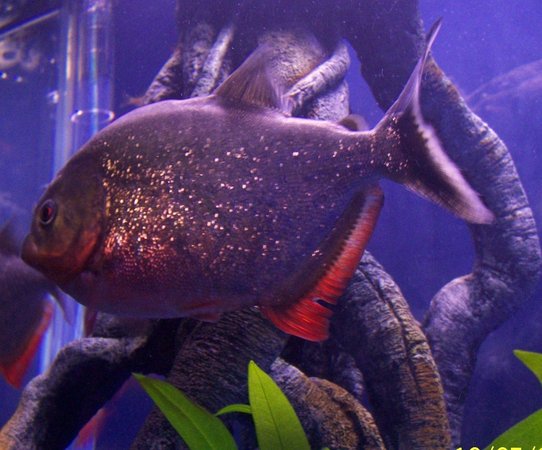 From time to time, he makes sharp circular movements around the nest and flaps his fins, creating the necessary flow of water. For proper hatching, it is recommended to use sufficiently coarse soil as a bottom substrate in the spawning ground. Since the fine soil quickly gets into piles and the actions of the male only speed up the process. As a result, some of the eggs suffocate. The hatched larvae do not have the strength to get out from under the shallow ground.
From time to time, he makes sharp circular movements around the nest and flaps his fins, creating the necessary flow of water. For proper hatching, it is recommended to use sufficiently coarse soil as a bottom substrate in the spawning ground. Since the fine soil quickly gets into piles and the actions of the male only speed up the process. As a result, some of the eggs suffocate. The hatched larvae do not have the strength to get out from under the shallow ground.
Then the activity of the male in caring for the nest decreases day by day. The floating larvae are now on their own.
Two days after spawning, a larva appears, and a week later, the juveniles begin to swim. Juveniles are recommended to be transferred to a separate tank. Their starter food may consist of brine shrimp nauplii, and later you can feed them motel and other live foods.
With good nutrition, juveniles grow very quickly. At the age of one month, juveniles resemble small shiny coins with a dark spot at the beginning of the caudal fin.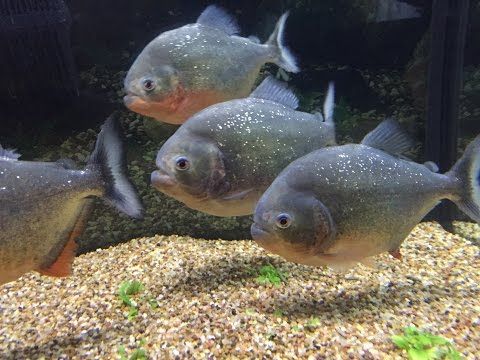
A month later, new dark spots appear on their body. At the age of three months, their lower jaw becomes more pronounced and their fins become colored. Now they are completely similar to adults.
At this age, it is important to add fish and meat to the diet of young animals, as well as cut shrimp. When switching to such food, you should be very careful about the quality of the water in the aquarium.
If spawning takes place in a community tank, larvae and juveniles can grow in it. They will not attract the attention of adult piranhas.
The danger of being eaten becomes serious when juveniles reach 5 cm in size. In a single spawning area, such problems may arise when the fish become reproductive.
Aquarium fish Red-bellied piranha. Keeping, breeding, feeding, photo
Photo of Common piranha Representatives of the genus Pygocentrus are characterized by several features, among which are the number of teeth on the chest in front of the pelvic fins, the morphology of the swim bladder and skull, the width of the head. The fish lack rays in the adipose fin, while the dorsal fin has 14-18 branched rays (usually 15). Anterior to the first pterygiophore (supporting element in the dorsal fin) are 5 to 7 (usually 6) first spinous processes of the superior vertebral arch. The spine usually consists of 35-38 (usually 36) vertebrae. Shoulder spots of various sizes are relatively small or absent; spots on the body are numerous.
The fish lack rays in the adipose fin, while the dorsal fin has 14-18 branched rays (usually 15). Anterior to the first pterygiophore (supporting element in the dorsal fin) are 5 to 7 (usually 6) first spinous processes of the superior vertebral arch. The spine usually consists of 35-38 (usually 36) vertebrae. Shoulder spots of various sizes are relatively small or absent; spots on the body are numerous.
The common or red-bellied piranha is found in the Amazon Basin, Paraguay-Parana, northeastern Brazilian coastal rivers, and the Essequibo River. Voiced river basins are found in Argentina, Bolivia, Brazil, Colombia, Ecuador, Guyana, Peru and Uruguay.
This species grows to a rather impressive size - 30 cm. Its color depends on the habitat. On the underside of the body, it varies from yellowish to red, while the rest of the body is silvery, golden, or black. The shape of the head can also vary and depends, in particular, on the diet. In some specimens it is quite blunt, in others there is little or no concavity above the profile of the eyes. The size of the adipose fin is related to feeding habits and habitats, and sometimes it is quite tiny.
The size of the adipose fin is related to feeding habits and habitats, and sometimes it is quite tiny.
Contents
Piranhas in the Amazon
P.nattereri has a wide range of geographical variations. The southern population is characterized by a golden yellow belly and is often referred to as P.nattereri "ternetzi", which however is not a separate species. This designation appeared in 1908, when Steindachner described the damaged holotype, calling it Serrasalmo ternetzi. The name "superreds" is also common. However, the coloration may change, in particular in captivity, depending on feeding and housing conditions. Previously, there was even a special name for P.nattereri juveniles - "snake skin", which was associated with a special color pattern on the body. However, as the fish mature, they lose their juvenile coloration.
Red-bellied piranha photo (right view) (ill. piranhakeepers.com/topic/34-showcase-your-pygocentrus-nattereri/) Due to the paucity of field studies, very little is known about the gregarious behavior of red-bellied piranhas. In one such observation, Magurran A. and Queiroz H.L. studied three aspects of the behavior of predators: preference by individuals of partners in a flock with similar or different habitats; preference by individuals for partners of similar size or different; how individuals of different sizes behave in a pack.
In one such observation, Magurran A. and Queiroz H.L. studied three aspects of the behavior of predators: preference by individuals of partners in a flock with similar or different habitats; preference by individuals for partners of similar size or different; how individuals of different sizes behave in a pack.
They found that Pygocentrus nattereri did not divide pack members into individuals of similar habitats or outsiders. However, the researchers noted a preference for larger individuals to pack partners of similar size, while smaller individuals preferred smaller fellows. In addition, larger fish were more often observed in the center of the school, while smaller ones usually attacked the prey first. The reason for this is probably the adaptation of large and mature individuals to minimize the risk of being eaten by a predator, while small piranhas need to activate their foraging behavior in order to quickly reach sexual maturity.
This also explains why small piranhas often feed during daylight hours, while adults prefer twilight or low light conditions for feeding.
Although Pygocentrus nattereri are gregarious in nature, it is recommended to keep them alone in the aquarium. Piranhas are very hardy, but frequent skirmishes can lead to serious injuries that will shorten the life of the fish.
Red List Status: NE - not assessed or not listed
Keeping river piranhas
Since Pygocentrus nattereri reach a length of 30 cm, an aquarium with a volume of 350 liters or more is recommended for keeping them. The bottom is laid with any type of soil. Lighting should be moderate. The fish feel good at a water temperature of 22.8 - 27.8 ° C, hardness - 10 - 20 dGH and acidity 6.0-7.5.
Do not use commercial dry food, flakes or pellets in the daily diet. A meat diet (fish, shrimp, worms) with the addition of a vegetable component should prevail. You need to be careful while feeding, because the fish can bite your hand.
Reproduction
Aquarium-raised common piranhas (Pygocentrus nattereri) breed relatively easily at 18 months of age when they reach 15 cm in length. Since the sex of the fish is almost impossible to distinguish, breeders acquire 6-8 individuals and grow them together. In some cases, the male appears darker than the female, who also has a yellowish abdomen. For breeding, the acidity or hardness of the medium does not matter, but the temperature should be 25-27 ° C.
Since the sex of the fish is almost impossible to distinguish, breeders acquire 6-8 individuals and grow them together. In some cases, the male appears darker than the female, who also has a yellowish abdomen. For breeding, the acidity or hardness of the medium does not matter, but the temperature should be 25-27 ° C.
Piranhas can spawn both in a community tank and in a separate tank. In the latter case, an aquarium with a volume of 200 liters (preferably 400) is used. They provide water purification with a powerful canister filter and lay fine gravel as a substrate. It is recommended to place plants floating on the surface, which darken the aquarium and calm the fish.
The beginning of the breeding season can be easily identified by the start of nest building, the darkening of the color of the producers and their departure from the flock. Spawning is stimulated by the addition of fish and fresh meat, as well as an increase in temperature to 28 ° C. Some aquarists lower the water level and then top up with fresh water.










